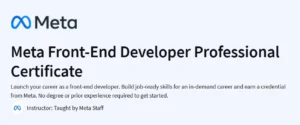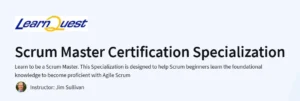Introduction to Front-End Development Course
A comprehensive beginner-friendly course that provides practical insights into front-end development, perfect for those starting a career in web development.
|
What you will learn in Introduction to Front-End Development
-
Understand the roles and responsibilities of front-end developers.
-
Gain foundational knowledge of core web technologies, including HTML, CSS, and JavaScript.
-
Create and style simple webpages using HTML and CSS.
-
Explore modern UI frameworks such as Bootstrap and React.
-
Develop a responsive webpage that adapts to various screen sizes.
Program Overview
Module 1: Get Started with Web Development
⏳ 5 hours
- Learn about different types of web developers and their roles. Explore the core technologies of HTML, CSS, and JavaScript, and understand the basics of how the internet works.
Module 2: Introduction to HTML5 and CSS
⏳ 5 hours
- Dive into HTML5 and CSS to construct HTML documents and apply basic styling and layouts using CSS
Module 3: UI Frameworks
⏳ 5 hours
- Get introduced to modern UI frameworks like Bootstrap and React, and learn how they facilitate the creation of interactive user experiences.
Module 4: End-of-Course Graded Assessment
⏳ 4 hours
- Apply your knowledge by creating and editing a responsive webpage using HTML and the Bootstrap CSS framework
Get certificate
Job Outlook
-
Completing this course prepares you for entry-level roles such as Front-End Developer or Web Developer.
-
The skills acquired are applicable across various industries that utilize web development practices.
-
Enhance your employability by gaining practical experience in front-end development fundamentals.
Explore More Learning Paths
Enhance your front-end development expertise with these carefully selected programs designed to strengthen your coding skills, UI/UX understanding, and professional development readiness.
Related Courses
-
Meta Front-End Developer Professional Certificate Course – Gain comprehensive training in front-end development with real-world projects and industry-recognized skills.
-
Microsoft Front-End Developer Professional Certificate Course – Learn front-end development fundamentals and advanced techniques, guided by Microsoft’s expert curriculum.
-
IBM Front-End Developer Professional Certificate Course – Master front-end technologies, frameworks, and best practices through IBM’s professional program.
Related Reading
-
What Is Python Used For – Discover how Python compares to front-end languages and how it can complement your web development projects.
- No prior experience required, making it accessible to beginners.
- Self-paced learning with a flexible schedule.
- Taught by experienced instructors from Meta.
- Provides a holistic view of front-end development, encompassing technical and practical perspectives.
- Requires consistent time commitment to complete all modules within the recommended timeframe.
- May require supplementary resources for those seeking in-depth technical skills beyond the scope of the course.
Specification: Introduction to Front-End Development Course
|
FAQs
- A modern web browser (Chrome, Firefox, or Edge) is sufficient.
- A simple text editor (VS Code recommended) is enough for coding.
- No expensive software or paid tools are required.
- Free extensions can improve workflow but are optional.
- The setup can be done in under 30 minutes.
- No prior coding background is needed.
- The course starts from the very basics of HTML and CSS.
- JavaScript concepts are introduced gradually.
- Real examples and exercises guide learning.
- Motivation and practice matter more than experience.
- Yes, you’ll be able to create functional, styled web pages.
- You’ll gain confidence in building responsive layouts.
- Small real-world projects can be added to your portfolio.
- You’ll understand how frameworks like Bootstrap and React fit in.
- Advanced projects may require further learning beyond this course.
- Builds a strong foundation for entry-level developer roles.
- Provides a certificate to showcase in resumes and LinkedIn.
- Teaches industry-relevant skills employers expect.
- Demonstrates ability to create responsive websites.
- Can be combined with additional practice to strengthen portfolios.
- Learn deeper JavaScript concepts (ES6, DOM manipulation).
- Explore React or another modern framework in detail.
- Practice Git and GitHub for version control.
- Study backend basics (Node.js, databases) for full-stack skills.
- Take on personal projects to strengthen hands-on experience.





